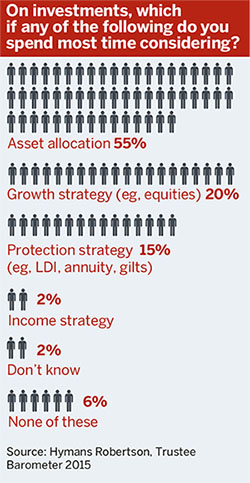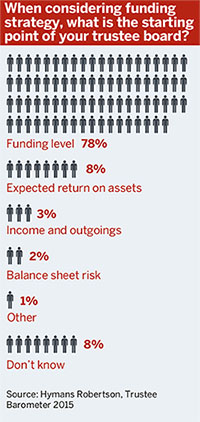Feature: Sweeping closures of defined benefit schemes across the UK will limit the pain of future liabilities for sponsors, but have created a growing problem many pension funds have been slow to recognise: a cash flow crisis is on the horizon.

Mark Zuckerberg pledged to give away 99 per cent of his Facebook shares – an estimated $45bn (29.8bn) – during the course of his lifetime, after the birth of his first child last week.
The Facebook founder dedicated the long-term cash stream to advancing human potential and promoting equality through funding non-profits, private investment and participation in policy debate.
With a personal wealth estimated at $44.6bn, Zuckerberg can well afford to channel a steady cash flow towards philanthropic causes over the next 50, 60 or even 70 years.
But for many of the UK’s DB pension schemes, meeting cash payments when they fall due will not be quite so easy.
According to analysis by consultancy Hymans Robertson as part of its 2015 'Trustee Barometer', 50 per cent of FTSE 350 schemes are cash flow negative – the value of outgoing benefit payments exceeds money entering the scheme through contributions.
Across the UK’s DB sector, schemes pay out £20bn more in cash than they receive in contributions, Hymans says. This figure is predicted to rise above £100bn over the next 15 years as schemes are hit by the impact of:
• reducing numbers of active members;
• increased closures resulting from rises in cost due to low long-term returns;
• national insurance costs increasing in line with the abolition of contracting-out;
• sponsor reluctance to inject cash into the scheme;
• higher numbers of members transferring out under pension freedoms.
It’s keeping the best of the new world balance sheet focus but complimenting it with some of the good stuff we used to have around cash flow planning for a more rounded risk management plan
Calum Cooper, Hymans Robertson
Unrecognised risk
Meeting benefit obligations as they fall due is schemes’ raison d’être, but the challenge of meeting those payments without suffering significant capital losses has gone largely unrecognised among scheme trustees.
Almost three-quarters (72 per cent) of 100 trustee respondents to the Trustee Barometer say they are at low risk of having to sell assets, while just 3 per cent identified incomings and outgoings as the starting point for their funding strategy.
The picture acrossindependent trustees surveyed separately by Hymans is quite different.

While just 4 per cent of lay trustees said they were at a stage where they needed to evolve their strategy to cope with negative cash flows, 46 per cent of independent trustees agreed with the statement.
Calum Cooper, partner and head of trustee consulting at Hymans Robertson, says advances in investment ‘science’ over recent years has moved the industry away from an older-world focus on matching up income with liabilities – a crucial focus for trustees as schemes mature.
“It’s keeping the best of the new-world balance sheet focus but complementing it with some of the good stuff we used to have around cash flow planning for a more rounded risk management plan,” says Cooper.
Jerome Melcer, partner at consultancy PwC, says the pressure of ballooning deficits and increasing liabilities has encouraged trustees and sponsors to evaluate scheme risk on a balance sheet basis.
But he adds: “This doesn’t pick up slow-burning issues that develop over time such as cash flow strain.
“This has implications for governance, investment strategy and company funding costs in the longer term.”
Cash-hungry schemes
Minimising the risk of becoming a forced seller demands a shift in focus for scheme investment strategies.
Schemes need their investment strategy to deliver not only efficient returns per unit of risk, but also to account for the scheme becoming very “cash flow hungry”, says Cooper.

“A number of folks, just in terms of cost efficiency, are switching income on from their assets rather than reinvesting and then divesting to pay benefits,” he says.
Trustees are beginning to think about assets less in terms of traditional growth and matching assets, instead targeting growth to clear deficits, income to deliver cash flows and protection to dampen interest rate, inflation and longevity risks.
Cooper adds: “There are illiquid assets that deliver good income and good total returns – whether it’s a multi-income fund, various forms of credit, farmland, timberland or secure property.”
However, Melcer says increased interest and allocation to income-seeking assets must be matched with a corresponding increase in oversight and governance.
Many schemes currently have an ad hoc arrangement in place for assessing which assets to sell if cash is running low, but as the strain increases this oversight must become more substantive, he says.
“Do trustees have an adequate plan for managing liquidity? To do this effectively, trustees and their advisers will need to have visibility on cash flow, out and in, for the next few years, with clarity around how they finance the shortfall,” he says.
The transaction market may also be a resource for schemes seeking to manage their liquidity requirements more effectively.
“Buy-in contracts are highly efficient generators of liquidity,” says Melcer. “For many schemes, a switch of assets from gilts or bonds to a buy-in covering some or all pensioners could address cash flow needs for the next decade or so.”
Firefighting
For schemes already feeling the cash strain, Cooper says it is crucial to focus forced divestments on asset classes that have done well.
“If you’re diversified across a range of asset classes then you can divest from the classes that have performed well – do it in more of a planned way.”
Restructuring assets away from a 50/50 growth and matching structure may also reduce the likelihood of being forced to sell out of volatile assets in a persistent bear market, he says.
Cooper proposes a portfolio structured 70 per cent in debt that delivers a steady income, 10 per cent in equities, and 20 per cent in liability-driven investments – which delivers similar protections to the previous 50 per cent held in matching assets.
Market innovation
Matching off the coupons of maturing bonds with payments as they fall due would drive efficiency across schemes’ portfolio, says William Parry, investment consultant at Buck Consultants.
“The difficulty is finding the right mix of assets to do that,” he says.
With the yield on traditional public debt below 2 per cent and more esoteric types of credit offering 5-6 per cent but carrying significant risk of capital loss, the market is on the hunt for something that could deliver this.
Parry says managers are increasingly focusing on structuring a solution for schemes on both a pooled and segregated basis, but identifies a broader misconception in the market.
“People lump asset values susceptible to capital value falls in with what could be cash flow matching assets,” he says.
“When those values fall, the income that you’re drawing off those also falls. If that income is falling you’re hardly matching a cash flow.”














